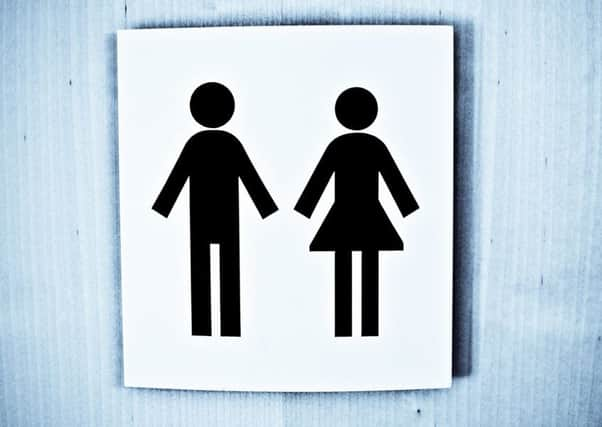Darren McGarvey: Gender neutral toilets are proxy for wider battle


The topic of gender has come to dominate the news in recent years and rightly so.
Last week, a massive row erupted within the BBC, regarded as a socially progressive, modern institution, as television and radio personalities came under intense media scrutiny over their salaries. Figures revealed that there remains a massive disparity between what males and females are paid, often for performing similar roles, and this triggered a slew of think pieces on the issue of gender. However, most people would be forgiven for not feeling particularly connected to the plight of hard-up media professionals earning more than £150,000-a-year.
Advertisement
Hide AdAdvertisement
Hide AdThat said, the issue of gender impacts all of us in myriad ways, not least those who don’t fall neatly into one of the two main categories: male and female. And while we’re all equally unlikely to see the sort of money Graham Norton or Fiona Bruce are currently clearing, one aspect of life that does affect us all equally is the fact that no matter how famous we get, we still have to use communal toilets at work. It’s in this slightly less glamourous arena that the issue of gender is transforming our collective conception of what going to the lavatory should entail.
Gender neutral toilets, sometimes referred to as ‘unisex’, have been quietly becoming the norm in the last couple of years despite the idea of them often provoking heated debate – mostly online. They are designed, primarily, to be more inclusive for transgender and non-binary people who can often face barriers that many of us may not perceive. Much like ramps and elevators are mandatory in public buildings, to allow access for people using wheelchairs, genderless restrooms are about recognising the male/female dichotomy does not apply to everyone.
Gender neutral toilets are one of those issues that have so far generated more heat than light. The issue has become a proxy in the wider battle between advocates of intersectionality – a theory that attempts to account for how minority groups are disadvantaged – and those of a more traditional disposition, who think campaigners walk a fine line between fighting for equality and just making stuff up. Granted, the subject of gender can often make for strained conversation on social media, due to a broad diversity of opinion and experience on the issue, but such debate often obscures the reality of the issue being discussed. Gender neutral toilets are far more banal than they might sound.
In fact, you’ve probably already used one.
Rather than a big free-for-all, where little girls go to the toilet and then wash their hands in the same physical space as grown men, gender neutral toilets are usually self-contained rooms, completely walled off from each other, often in a row of four or five. The only clue they are genderless is the sign on the door, which indicates the toilet is not gender specific. That means whether you are male, female or identify as either a bit of both or something in between, then you should feel welcome to use that bathroom. Many scaremongers claimed that genderless restrooms would lead to perverts using transsexual rights as a means of abusing woman in bathrooms but the reality of gender neutral toilets is so utterly unremarkable that one wonders why there is still such heated debate on the issue.
Of course, like the issue of gender itself, the ongoing discussion about the topic, across the Western world, doesn’t fall easily into two distinct categories. The debate is made doubly difficult by the fact people often make no distinction between moral claims like ‘people shouldn’t be discriminated against based on their gender’ and empirical claims like ‘men and woman are biologically indistinguishable’.
Some believe gender is socialised, learned behaviour, whereas others believe gender is expansive; a matter of what an individual chooses to identify as. Then there’s the subtle distinctions between gender, sex and sexual orientation. And there is the thorny issue of science, which tends to view gender through a biological lens.
Discussion on the matter can often get bogged down in misunderstanding due to the subjective nature of the issue as well as bad blood between the various schools of thought. Which is why it helps to actually look at the issue you’re arguing over every now and then, as opposed to debating over a caricature. In every instance that I’ve seen gender neutral toilets, whether in cafe chains like Café Nero, vegan eateries or public buildings, they’ve been not only utterly inoffensive, but also felt far more natural than needlessly segregated restrooms. Gender neutral usually just means you might be going through the wall from someone of the opposite sex (or gender) as opposed to how it’s often perceived, as some kind of invasive and potentially dangerous experience.
Which brings me to my final point. If merely the idea of a gender neutral bathroom is enough to frighten you, then you can understand why transgender or non-binary people might be anxious when faced with the prospect of having to use a toilet that doesn’t correspond with how they look or feel. Yes, the issue of gender does throw up some complicated conundrums and there are certainly factions within the debate that seem more interested in recrimination than they do discussion. It’s also unfortunate that debate around the issue is conflated with denying a person’s right to exist.
Advertisement
Hide AdAdvertisement
Hide AdBut we shouldn’t let these issues, which are a natural part of social progress, obscure just how simple – and safe – genderless bathrooms really are.
As a man, I can say that I actually prefer them. Then again, this isn’t about me.
Darren McGarvey is also known as Loki, a Scottish rapper and social commentator @lokiscottishrap